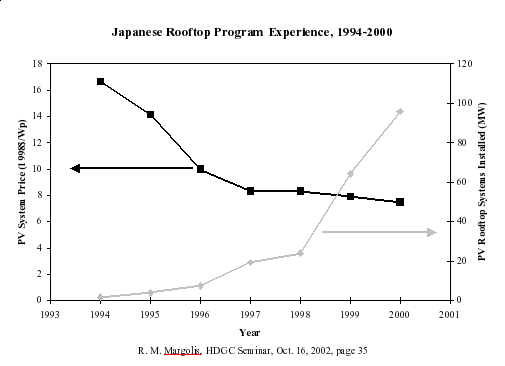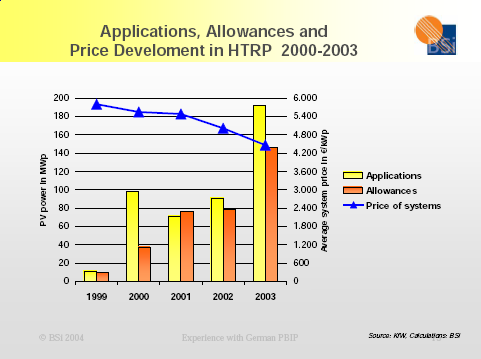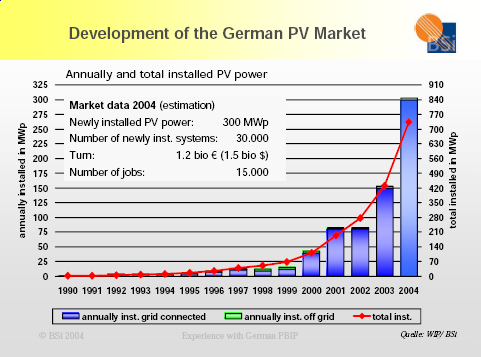SUMMARY: Ken Livingstone's solar panels for City Hall are nearly ready to switch on. They cost something over half a million pounds, and could reasonably be expected to deliver around 75 MWh a year (not enough for 20 typical houses). For the same money, you could get over 2,000 MWh from a wind turbine, maybe 8,000 MWh from conversion of waste to energy, and yet more carbon-savings if invested into renewable heat or insulation improvements for London houses. Or he could simply have let taxpayers keep their money and make their own decisions about what to do with it. What follows is an examination of whether there are any rational grounds for this sort of wasteful expenditure, or whether this is a classic example of the triumph of style over substance.
+++++++++++++++
Demos recently published a booklet called The Disrupters, on the subject of low-carbon innovation. There's a lot of nu-speak, and not much consideration of hard economics, but it's not a bad publication - some of the examples cited are genuinely interesting, and some of the lessons taken from their experiences are the right ones. It provides the jumping-off point for this post not because of the publication itself, but because of a picture that they casually used today to promote their podcast on the subject.
It is a picture of City Hall, home of Ken Livingstone and the Greater London Authority, in which solar panels can just be seen being installed. I hadn't realised they were going solar at the GLA, but, photovoltaics (PV) being the least economic of all renewables, I thought I'd look into it a little to see what we could learn from this case.
The most detailed information available comes from the London Climate Change Agency (LCCA), which states that they are installing 70 kW of panels, which will generate "3.1million kWh of renewable electricity over their lifetime". This, they say, "will reduce the CO2 emissions of City Hall by 3,000 tonnes in its lifetime – enough to fill 3,000 hot air balloons". Elsewhere, we find the Authority scaling this down to 1,000 tonnes of CO2-savings over a 20-year lifetime, though still filling 3,000 balloons. 3,000 tonnes is quoted on another site. Let's assume the intended figures are 3,000 tonnes and 20 years. How does that stack up?
Firstly, they don't say whether that 70 kW is kWp (peak kW), the usual way in which PV capacity is quoted, but assuming that is the intention, 3.1 million kWh over 20 years is wildly optimistic. Taking typical efficiencies and load factors for PV, you would expect around half of that.
If it did generate that much power, it is unlikely to save that much carbon. Estimating how much carbon is avoided from power stations through the use of renewables is always a bit rough, because you don't know what exact mix of generation and system losses would have been avoided. But a typical figure is around 1,500 kWh avoids 1 tonne of carbon. The carbon-efficiency of our generating mix is expected to increase in the future, so this is an optimistic figure as an average over 20 years. But on that optimistic basis, the project would save less than 2,100 tonnes of CO2 (less than 600 tonnes of carbon) in the unlikely event that it produced this amount of power.
The key figure, though, is not the total savings but the value of the savings. How much do these savings cost in £/tCO2 (tonnes of CO2) or £/tC (tonnes of carbon)?
Not surprisingly or unusually, the GLA are rather coy about the costs of the project. However, we learn that they have received £270,757 in grants from the Solar Photovoltaics Major Demonstration Programme, part of the Low Carbon Buildings Programme, administered by the Energy Savings Trust. It is not clear whether this was under Phase 1 or Phase 2 of the programme, but more likely Phase 1, given that the grant was awarded in mid-2005. If so, the maximum grant-funding allowed was 40% (if Phase 2, 50%). That makes it likely that the project cost more than £676,000, and certainly no less than £541,000 (ex VAT).
The electricity produced is unlikely to be worth more than £270,000 (undiscounted) over the lifetime of the project, and more likely to be less than £200,000. Generously assuming (for the sake of simplicity) no maintenance costs, that leaves a gap of at least £270,000 in the project economics (effectively, the premium for the "greenness") and more likely getting on for £500,000. If the cash-flow were discounted, as it should be, the annual amount and value of the electricity produced is so small that the deficit in the project economics would not be much less than the capital cost - best case: £360,000; likely case: > £550,000.
That makes £120/tCO2 (£440/tC) the best that this project can possibly do in terms of the cost of the carbon-savings. It is much more likely to be over £260/tCO2, that is heading for £1,000/tC. By contrast, typical estimates of the social cost of carbon (from organisations such as the EU, the Treasury and the Stern Report) have been in the £30 - 70/tC range (£8 - 19/tC). The cost of carbon in the European Emissions Trading Scheme (EU-ETS) is less than £0.10/tCO2 this year, and around £14/tCO2 for forthcoming years. The cost of the Renewables Obligation (RO) mechanism to support renewable-electricity generation (from which this scheme should also benefit) is around £75/tCO2 if we are at around 65% of the target output. The government is currently changing the RO on the pretext that it over-rewards the carbon-savings from some technologies. The Climate-Change Levy equates to a carbon-price of around £37/tC (less for coal, more for gas).
As those who have read my previous postings on carbon-values (e.g. here, here or here) will be aware, I regard none of these prices as realistic. But of one thing I am certain - whatever carbon-savings are worth, they are not worth more because they are achieved by using solar panels than if they are achieved by any other means. The simple question to ask yourself is: if you had £1,000 to spend to save carbon, would it be better to spend it on PV to save one tonne, or on a cheap solution that could save twenty tonnes? Subsidising expensive solutions isn't green, it's wasteful, and that is the opposite of green.
The usual excuse for huge government bungs for expensive technology is that the "pump needs priming", so that economies of scale can be achieved, and learning curves can be descended. The technology will then become competitive, and the nation that invested to prime the pump will reap the rewards of their investment by selling their technology and expertise to other countries. Of course, if it were that easy, industrial policy would be simple. It is a fantasy to imagine that all government has to do is stick enough money into a technology and it will become economic. True returns come from spotting a gap in the market or from innovating to deliver specific savings, not from some simplistic notion that costs are bound to come down if you throw money at it. Governments are pretty good at the generalist, throwing money bit, but not so good at the market-awareness and detailed innovation aspects. Hence the tendency of government to fund white elephants.
So is PV the exception that will restore government's reputation? Fortunately, we have a couple of test-beds, where we can see the effect of huge incentives on bringing down costs. First Japan, and then Germany, have thrown money at this technology. Costs have indeed fallen as a result. But does the trend suggest that PV is likely to be economic any time soon?
Strangely, given that the point of government funding is to discover whether efficiencies can be achieved, it is very hard to find straightforward analysis of price trends for PV in Japan and Germany. There are large numbers of studies on learning curves, but they all concentrate on what might happen in the future on the basis of assumptions of learning curves, and not whether those assumptions are borne out by reality. This, of course, is because all the studies are driven by the desire of government and academics to justify past, current and future spending, and not by genuine critical enquiry.
Nevertheless, one can fish a bit of information out of the odd study. The following graph for Japan is taken from here.

And for Germany, we have this:

That looks a bit better than the Japanese example, but there is something strange about this. The paper was produced in 2004, and in other respects it included data for 2004. For example:

It must be easier to know before year-end what the typical cost of equipment was that year than what the total installed capacity would be. Why include the capacity growth, but not the system price? If the learning curve theories are right, where a doubling of capacity results in a 20% reduction in cost, there should have been a significant reduction (getting on for 20%) in 2004. Something worth shouting about, you would have thought.
Germany continued to throw money at PV, and 2005 and 2006 were further bumper years for installation of PV panels. Yet I have not been able to identify any study of the learning curve beyond 2004. But I have been able to find a statement on the more recent trend of prices. According to an article entitled "Economic feasibility of PV systems in Germany", dated April 2006, on SolarServer.de, the Forum for Solar Energy:
"A survey conducted by the Photon magazine showed that the prices at the beginning of 2006 had increased by approximately 10 % in comparison to the previous year. It is not uncommon that complete solar power systems are sold at a price of up to 5 000 Euro per kWp."
In other words, the learning curve had not just flattened off, it had gone into reverse. An unlearning curve? The cost of experience?
Whatever you call it, you can see in both the Japanese and the German experience that the big reductions in cost occurred in the early years before the big increases in capacity, and that, as one might expect if one were not an economist, a politician or a businessman looking for government hand-outs, reductions in costs getting increasingly hard to achieve once the more obvious and significant efficiencies have been delivered.
This will change. More manufacturing capacity will come online, new technologies will be deployed, and prices will fall again. But the point is that an assumption of a steady 20% fall in cost for every doubling of capacity is complete rubbish. It's the sort of thing bad economists like, because it makes their job nice and easy. But it is a hopeless generalization. Of course there are sometimes economies of scale and other savings. But they may occur in step-changes rather than on a steady curve. There is no guarantee that it will be continuous - there are limits to how cheaply one can make things regardless of volume, which only technological breakthroughs can change. Breakthroughs do not happen inevitably. Their effect may be countered by opposing pressures, such as increased demand for components from scaling of production resulting in higher prices for those materials (which is what has been happening to the silicon wafers in PV panels recently). And there may be cherry-picking effects, where the best opportunities get used up, and what is left is naturally more expensive.
There is plenty of reason to doubt that the cost of PV will continue to fall by 20% for each doubling of capacity. But let's say that it does. What would it take to bring PV to the point where it is competitive against other mature renewables? Not against fossil-fired energy, mind, or against energy-efficiency measures, both of which would require further reductions in the cost of PV, but simply to compete against alternative forms of renewable electricity generation. For those purposes, the cost of PV would have to fall below €1,000/kWp. Given a cost in 2006 of €5,000/kWp, capacity would have to double seven or eight times to achieve a competitive cost. That is a multiple of between 128 and 256. With installed capacity in Germany amounting to around 1.5 GW in 2006, that would take PV capacity to between 192 and 384 GW. Germany's total generating capacity is around 120 GW. It is safe to say that such an increase is improbable.
Of course, the capacity-increase could be spread around a number of countries, but equally you would then have to take the global installed capacity as the starting point. That was something over 4 GW in 2006. So we'd need somewhere between 500 and 1,000 GW of PV installed before it became economic. At an average price over that curve of around €2,000/kWp (or €1,000/kWp over the economically sustainable price), we'd have to spend €1-2 trillion before PV became economic, of which €500-1,000 billion would not be recoverable even if the electricity received as much support as other mature renewables.
It's fantasy of course. But that has never held politicians back from backing a loser with taxpayers' money, however obvious its failings may be. According to our Energy Minister, Malcolm Wickes, announcing the grants to projects such as City Hall, "Solar is a clean, green energy source that the government is supporting through this funding programme and which we will continue to support in future with the Low Carbon Building strategy currently being developed." Ken Livingstone reinforced this judgment: "As City Hall is now one of London's most recognisable landmarks it is right that we take a lead in cutting CO2 emissions. I hope that other agencies and firms will now start to copy our lead and install solar panels on their own buildings."
Installation should be completed during August. I trust Ken will keep us all informed of the costs, production and value of the project. It should be a valuable learning experience. If politicians were inclined to learn, that is.

